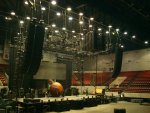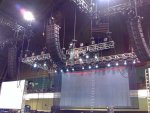I posted this over at Prosoundweb and it was suggested that I post it here as well. If you have already read this in the other audio community I apologize for the double posting.
Tim McCulloch suggested that Evan Kirkendall might be able to shed some light on this. So Evan if your reading please chime in. Or anybody else that may have thoughts.
A couple of months back on the Carrie Underwood tour we set up an interesting sub array as follows.
There were 2 rows of 8, front loaded, 2 x 18 bowtie Clair subs facing each other about 2 feet apart. The boxes in each row were tight together (in my memory). These were all under stage right. It is my understanding from replies at prosoundweb that this is an end fire array. (Which is what I thought). I am wondering what the math is behind the spacing between the 2 rows. I assuming it is not arbitrary since the sub tech laid down a specially cut piece of plywood before we set each sub in place. The spacing as I mentioned was about 2 feet (I don't know the exact measurement however).
The sub tech was telling me that he could setup a hammock behind the array and hear very little (if any sub) during the show.
I walked around from backstage to out in front and there was indeed very little sub at the back and plenty of sub out front (as I would expect from an end fire array).
The sub tech then went on to explain that they could steer the subs by delaying the onstage row in relation to the off stage row.
I am hoping that someone could give me a more detailed description of the inner workings of this array.
I have been doing lots of research and calculations and for the life of me I cannot figure out exactly what is going on here.
Thanks in advance for any and all replies.
Happy mixing!
John Vaneldik
Tim McCulloch suggested that Evan Kirkendall might be able to shed some light on this. So Evan if your reading please chime in. Or anybody else that may have thoughts.
A couple of months back on the Carrie Underwood tour we set up an interesting sub array as follows.
There were 2 rows of 8, front loaded, 2 x 18 bowtie Clair subs facing each other about 2 feet apart. The boxes in each row were tight together (in my memory). These were all under stage right. It is my understanding from replies at prosoundweb that this is an end fire array. (Which is what I thought). I am wondering what the math is behind the spacing between the 2 rows. I assuming it is not arbitrary since the sub tech laid down a specially cut piece of plywood before we set each sub in place. The spacing as I mentioned was about 2 feet (I don't know the exact measurement however).
The sub tech was telling me that he could setup a hammock behind the array and hear very little (if any sub) during the show.
I walked around from backstage to out in front and there was indeed very little sub at the back and plenty of sub out front (as I would expect from an end fire array).
The sub tech then went on to explain that they could steer the subs by delaying the onstage row in relation to the off stage row.
I am hoping that someone could give me a more detailed description of the inner workings of this array.
I have been doing lots of research and calculations and for the life of me I cannot figure out exactly what is going on here.
Thanks in advance for any and all replies.
Happy mixing!
John Vaneldik


